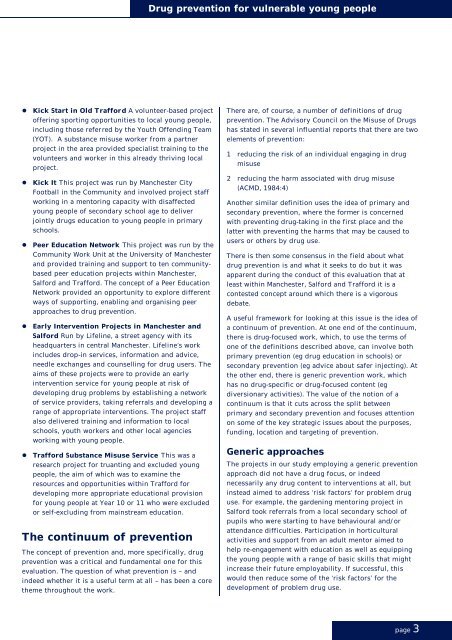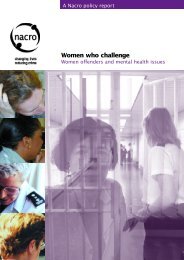Drug prevention for vulnerable young people - Nacro
Drug prevention for vulnerable young people - Nacro
Drug prevention for vulnerable young people - Nacro
You also want an ePaper? Increase the reach of your titles
YUMPU automatically turns print PDFs into web optimized ePapers that Google loves.
<strong>Drug</strong> <strong>prevention</strong> <strong>for</strong> <strong>vulnerable</strong> <strong>young</strong> <strong>people</strong>• Kick Start in Old Traf<strong>for</strong>d A volunteer-based projectoffering sporting opportunities to local <strong>young</strong> <strong>people</strong>,including those referred by the Youth Offending Team(YOT). A substance misuse worker from a partnerproject in the area provided specialist training to thevolunteers and worker in this already thriving localproject.• Kick It This project was run by Manchester CityFootball in the Community and involved project staffworking in a mentoring capacity with disaffected<strong>young</strong> <strong>people</strong> of secondary school age to deliverjointly drugs education to <strong>young</strong> <strong>people</strong> in primaryschools.• Peer Education Network This project was run by theCommunity Work Unit at the University of Manchesterand provided training and support to ten communitybasedpeer education projects within Manchester,Sal<strong>for</strong>d and Traf<strong>for</strong>d. The concept of a Peer EducationNetwork provided an opportunity to explore differentways of supporting, enabling and organising peerapproaches to drug <strong>prevention</strong>.• Early Intervention Projects in Manchester andSal<strong>for</strong>d Run by Lifeline, a street agency with itsheadquarters in central Manchester. Lifeline’s workincludes drop-in services, in<strong>for</strong>mation and advice,needle exchanges and counselling <strong>for</strong> drug users. Theaims of these projects were to provide an earlyintervention service <strong>for</strong> <strong>young</strong> <strong>people</strong> at risk ofdeveloping drug problems by establishing a networkof service providers, taking referrals and developing arange of appropriate interventions. The project staffalso delivered training and in<strong>for</strong>mation to localschools, youth workers and other local agenciesworking with <strong>young</strong> <strong>people</strong>.• Traf<strong>for</strong>d Substance Misuse Service This was aresearch project <strong>for</strong> truanting and excluded <strong>young</strong><strong>people</strong>, the aim of which was to examine theresources and opportunities within Traf<strong>for</strong>d <strong>for</strong>developing more appropriate educational provision<strong>for</strong> <strong>young</strong> <strong>people</strong> at Year 10 or 11 who were excludedor self-excluding from mainstream education.The continuum of <strong>prevention</strong>The concept of <strong>prevention</strong> and, more specifically, drug<strong>prevention</strong> was a critical and fundamental one <strong>for</strong> thisevaluation. The question of what <strong>prevention</strong> is – andindeed whether it is a useful term at all – has been a coretheme throughout the work.There are, of course, a number of definitions of drug<strong>prevention</strong>. The Advisory Council on the Misuse of <strong>Drug</strong>shas stated in several influential reports that there are twoelements of <strong>prevention</strong>:1 reducing the risk of an individual engaging in drugmisuse2 reducing the harm associated with drug misuse(ACMD, 1984:4)Another similar definition uses the idea of primary andsecondary <strong>prevention</strong>, where the <strong>for</strong>mer is concernedwith preventing drug-taking in the first place and thelatter with preventing the harms that may be caused tousers or others by drug use.There is then some consensus in the field about whatdrug <strong>prevention</strong> is and what it seeks to do but it wasapparent during the conduct of this evaluation that atleast within Manchester, Sal<strong>for</strong>d and Traf<strong>for</strong>d it is acontested concept around which there is a vigorousdebate.A useful framework <strong>for</strong> looking at this issue is the idea ofa continuum of <strong>prevention</strong>. At one end of the continuum,there is drug-focused work, which, to use the terms ofone of the definitions described above, can involve bothprimary <strong>prevention</strong> (eg drug education in schools) orsecondary <strong>prevention</strong> (eg advice about safer injecting). Atthe other end, there is generic <strong>prevention</strong> work, whichhas no drug-specific or drug-focused content (egdiversionary activities). The value of the notion of acontinuum is that it cuts across the split betweenprimary and secondary <strong>prevention</strong> and focuses attentionon some of the key strategic issues about the purposes,funding, location and targeting of <strong>prevention</strong>.Generic approachesThe projects in our study employing a generic <strong>prevention</strong>approach did not have a drug focus, or indeednecessarily any drug content to interventions at all, butinstead aimed to address ‘risk factors’ <strong>for</strong> problem druguse. For example, the gardening mentoring project inSal<strong>for</strong>d took referrals from a local secondary school ofpupils who were starting to have behavioural and/orattendance difficulties. Participation in horticulturalactivities and support from an adult mentor aimed tohelp re-engagement with education as well as equippingthe <strong>young</strong> <strong>people</strong> with a range of basic skills that mightincrease their future employability. If successful, thiswould then reduce some of the ‘risk factors’ <strong>for</strong> thedevelopment of problem drug use.page 3
















